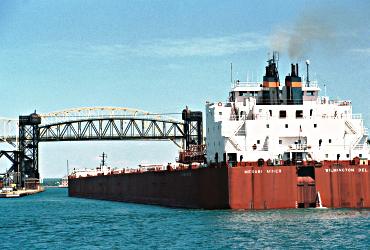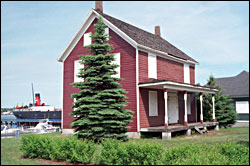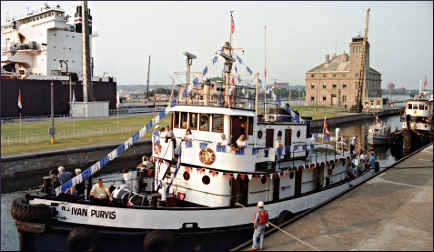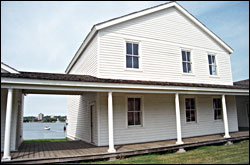Locking through the Soo
In Sault Ste. Marie, heavy traffic thrills boat watchers.

© Beth Gauper
In Sault Ste. Marie, tourists find out what floats their boats.
For most, it's watching serious machinery moving through the Soo Locks.
What really floats a boat, however, is 22 million gallons of water, which is what it takes to lift a boat through the Poe Lock, a liquid escalator between Lake Superior and Lake Huron.
It's a June evening at the Soo Locks, and the Earl W. Oglebay is coming from Silver Bay in Minnesota with a load of taconite. A camera aimed toward Lake Superior catches the 630-foot boat in the distance and projects it onto a TV monitor in the Visitors Center, where boat-watchers have started to gather.
As the boat approaches, we run outside, climb a viewing platform and watch it glide into the MacArthur Lock, with only 6 feet to spare on either side.
Its deck is nearly level with the concrete walkway, and Girl Scouts on a field trip shout a hello at the sailors throwing off bags of bed linens.
The sailors wave and start to check the hatches as water drains out of the lock and the boat sinks toward Lake Huron.
The Oglebay is a familiar sight at the Soo Locks, as is its beefier brother, the 1,000-foot Oglebay Norton.
Boat connoisseurs, however, are happier to see the older Earl Oglebay, whose twin maroon-and-gold smokestacks and tapered white prow give it a style the utilitarian Norton lacks.
"The new ones are just a barge with a pilot house on back," said Malvina Temple, who was staffing the desk of the U.S. Army Corps of Engineers Visitors Center in Soo Locks Park. "The older ones are so much classier."
I've found a pair of fellow boat-watchers in Temple and Doug Wolffis, who's come up from Muskegon, Mich., for his annual week of summer boat-watching; he also comes for a week in late September, when grain traffic picks up.
"My folks brought me up here when I was a kid, and I was hooked," said Wolffis, who calls himself a "boat nut."

© Beth Gauper
He keeps track of the boats by checking Internet sites, calling lockmasters and captains and listening to a scanner tuned to the Coast Guard frequency.
Once, he said, he was stopped and handcuffed by police in Muskegon when he was watching the Kaye Barker, a handsome Edmund Fitzgerald look-alike, while listening to his scanner.
So if he loves the big boats so much, why didn't he sign onto one when he was a young man?
"I got too comfortable," he said with a sigh. "Woulda, coulda, shoulda."
There are legions of boat watchers on the Great Lakes, and they're in their element at the Soo Locks, the bottleneck through which every Lake Superior-bound boat must pass.
Lake Superior, while connected to the other Great Lakes via the 63-mile-long St. Mary's River, is 21 feet higher, and most of the drop in elevation occurs at a mile-long stretch of rocky rapids — bawating in Ojibwe, sault in French.
The Ojibwe gathered there to fish, and a fur-trading settlement grew around the portage. Early miners had to go through carrying their iron and copper in wooden hogsheads. In 1845, an entrepreneur built a "strap railroad" with horse-drawn carts.
Locks were opened on the U.S. side in 1855, allowing boats to rise and fall within gated chambers from which valves allow water to enter and to drain.
Today, there are four locks; the Poe Lock, built in 1968, is the only one big enough to handle the 1,000-foot lakers.
During the shipping season, there's plenty of action. The next morning, the 1,000-foot Walter J. McCarthy came through on a coal run at 7 a.m., followed by the Presque Isle at 8:30.
At 11:10, we watched the upbound Canadian Prospector rise in the MacArthur Lock, so big it nearly blocked the view of Canada, as the downbound boat Lake Ontario sank in the Poe.
Doug Wolffis was there watching the Lake Ontario, which, he had heard, had a broken bow thruster and has had to use its propeller to create a cushion of water to help push it into position.

© Beth Gauper
"That's what I'm always watching for," he said, "how they're making the boat do what it's doing."
We got another view of the locks when we were inside one. Tour boats leave from both sides of the river, from Sault Ste. Marie, Mich., and Sault Ste. Marie, Ont., and both "lock through."
From a Soo Locks Boat Tours dock off Portage Avenue, along which voyageurs once ferried packs and canoes, we headed toward the locks.
We passed the massive Edison Sault hydroelectric plant, built in 1902, and a Coast Guard dock crowded with tugs, including the Corps' Paul Bunyan, a bulky gate lifter that looked like a department store with a crane attached.
The Herbert Jackson was in the MacArthur Lock, so we slid into the Poe, and soon 1½ million gallons a minute were hoisting us to Lake Superior level, where the 1,004-foot Mesabi Miner was waiting to enter.
From the lock, we motored under the International Bridge and up to the giant Algoma Steel plant, which has Canada's largest blast furnace, and returned through the Canadian lock, which handles recreational traffic.
After the international boundary was drawn in 1783, the fur trade settled on the Ontario side of the rapids.

© Beth Gauper
Today, Sault Ste. Marie, Ont., is five times bigger than its sister across the river and the third-biggest town on Lake Superior, after Thunder Bay and Duluth.
Though it has no shipping locks, it's much more of a party town than its smaller sister, with festivities swirling around the riverfront boardwalk, the Millennium Fountain and the white canopies of Roberta Bondar Pavilion and Park.
From the deck of our tour boat, we could see the Bushplane Heritage Centre, the Art Gallery of Algoma and the Norgoma, a retired passenger ship that's now a floating museum.
Nature trails and picnic areas line the Canadian lock and canal, and visitors can see remnants of the first lock, built in 1799 by the North West Co. and just wide enough for a Montreal canoe.
Everybody who was anybody came to the Soo over the years — Father Marquette, LaSalle, Etienne Brule. After the tour, we stopped by two frame houses being restored on the U.S. riverfront.
One was the home of Frederic Baraga, the Slovenian "snowshoe priest" who cemented his place in history through many years of frenetic travel between Ojibwe settlements in Sault Ste. Marie, La Pointe and Grand Portage — perhaps because the diocese didn't provide him with a house until 1864, 33 years after he arrived.
The other house was built in 1827 and belonged to the ubiquitous Henry Rowe Schoolcraft, the Indian agent who also roamed Lake Superior, exploring and collecting Ojibwe lore.
A sense of history pervades the Soo, carried in the wakes of the giant boats that come and go.
In the Locks Park visitors center, tourists from all over the world pepper the staff with questions about today's super freighters and the Edmund Fitzgerald, the ore boat that nose-dived to the bottom of Lake Superior off nearby Whitefish Point.
At the Valley Camp, a 1917 steam freighter that's now a museum, visitors marvel at the boat's steel innards, a maze of boilers, engine shafts, cylinders and generators whose joints required one sailor to do nothing but oil them.
In a world run by computer chips the size of fingernails, this industrial immensity is transfixing. And boats have only gotten bigger. The 1,000-footers fill the Poe Lock with only 2 feet to spare on each side, and their holds can carry freight from 600 rail cars.
Nose-to-nose, they're quite a sight. At the Soo Locks, big is what brings people running.

© Beth Gauper
Trip Tips: Sault Ste. Marie, Mich.
Getting there: It's nearly seven hours from Milwaukee, eight from Chicago and 10 from the Twin Cities.
Annual events: Last Friday of June, Soo Locks Engineers Day, when the Corps of Engineers allows the public to walk between the MacArthur and Poe locks and go into the Administration Building. Last Saturday of June, International Bridge Walk to Canada (bring a passport or enhanced drivers license).
Fourth of July weekend, Sault Tribe Powwow and Summer Gathering.
On the Ontario side of the locks, Canada Day festivities are July 1. Rotaryfest is in mid-July.
Soo Locks Visitors Center: The center has exhibits, helpful staff and a monitor on which visitors can watch ships approach.
Boat-watching: The boat-schedule hot line is 906-202-1333. Check the MarineTraffic map to see where approaching boats are on the lake. Check Boat Nerd for live views of the locks and information about Great Lakes shipping.
Passports: You'll need a passport or passport card to travel to or from Canada.
Boat tours: On the Michigan side, the 1¾-hour Original Soo Locks Boat Tours start at docks off East Portage Avenue, 800-432-6301.
Famous Soo Locks Boat Tours offers 90-minute lock tours and a 4½-hour lighthouse cruise once or twice a month along the St. Marys River to Point Iroquois Light and Canadian lights that include Gros Cap Reefs, 906-632-2512.
Both start at the docks off East Portage Avenue on the Michigan side.
On the Ontario side, the Miss Marie gives lock tours from its dock on the Roberta Bondar Boardwalk.
Kayaking: On Portage Avenue, Bird's Eye Outfitters offers guided trips through the locks and to the islands on the St. Mary's River and also rents kayaks.
Accommodations: The 1927 Hotel Ojibway is on the river next to the locks, but it doesn't really have a view, 800-654-2929.
The Lockview Motel is right across from the Soo Locks visitors center, 800-854-0745, and next to the Long Ships Motel, 888-690-2422.
On the Ontario side, the Delta Waterfront Hotel is right on the riverfront, and the Quality Inn and Holiday Inn Express are just behind it on Bay Street.
Dining: Right across from the locks on West Portage Avenue, Karl's Cuisine serves a varied menu and includes the Superior Coast Winery & Brewery.
On Ashmun Street, the Wicked Sister serves burgers, sandwiches and craft beer. And off the west end of Portage Avenue, the West Pier Drive-In is famous for its burgers.
Camping: The municipal Aune Osborn Campground has sites right on the river.
Day trips: From Sault Ste. Marie, Ont., the Agawa Canyon Tour Train takes passengers 114 miles into the scenic Canadian wilderness from Sault Ste. Marie, Ont., and back after a two-hour stopover. It's especially popular during fall-color season.
On Whitefish Point, about 80 minutes' drive from Sault Ste. Marie, Mich., the Great Lakes Shipwreck Museum tells about more than 300 wrecks in "the graveyard of the Great Lakes." The bell of the Edmund Fitzgerald, which sank near here with 29 men in 1975, occupies an exalted spot.
For more, see Graveyard of the Great Lakes.
Information: Sault Ste. Marie, Mich., tourism, 800-647-2858. Sault Ste. Marie, Ont., tourism, 800-461-6020.